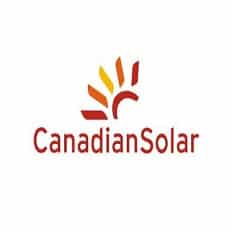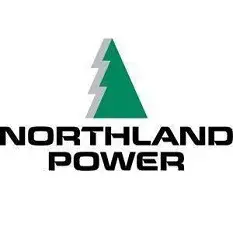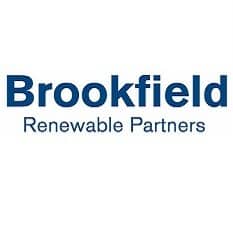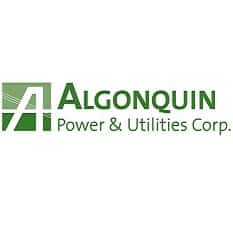Canada’s Top Renewable & Clean Energy Stocks for December 2024
No doubt, the whole world is shifting to greener and more sustainable energy sources. Fossil fuels might soon be outdated, and the world stands to gain big from using renewable energy.
How long will it take before Canadian renewable companies dominate the energy scene? It’s difficult to say. But if I were to guess, not long at all. That’s why you need to have a look at these Canadian stocks before it’s too late.
Let’s take a closer look at four renewable energy companies we think are the cream of the crop here in Canada.
What are the best Canadian renewable energy stocks?
- Canadian Solar Inc (NASDAQ:CSIQ)
- Northland Power (TSX:NPI)
- Brookfield Renewable Energy Partners (TSX:BEP.UN)
- Algonquin Power (TSE:AQN)
Canadian Solar Inc (NASDAQ:CSIQ)

One of the primary reasons we’ve never included a Canadian solar company on this list of renewable energy stocks is the fact that the best of the best trades down south on the NASDAQ.
However, due to increasing demand, we figured we’d start talking about Canadian Solar Inc (NASDAQ:CSIQ).
Solar stocks, in general, have surged as of late. After taking a large hit in price over the course of 2021, Canadian Solar recovered in a big way in 2022 and is one of the best-performing renewable energy companies in the space at the time of writing.
The stock has still dipped significantly from all-time highs achieved in 2021. However, this wasn’t unique to Canadian Solar, as all renewable energy companies went through a significant correction. But as we move forward, bullish sentiment is definitely returning.
We think investors, and analysts for that matter, are finally starting to see the potential in the once small cap Canadian (but U.S. traded) company.
Canadian Solar benefits from a fairly low cost of production and has a decent amount of projects planned for the future. Initially, solar power faced a lot of criticism. Production costs were extremely high, and it wasn’t looked at as a permanent solution to dirtier forms of power.
But the fact is, we wouldn’t even need to capture one-hundredth of a percent of the energy hitting the earth in a year to be able to scrap every other form of energy generation. And as costs of production come down, it’s becoming a more feasible clean energy generation method.
Interestingly enough, even with its large runup recently, Canadian Solar is still fairly valued considering the future of solar energy.
Trading at only 0.35 times sales and 7.5 times expected earnings, valuations are not outrageous. The company has been fairly inconsistent with its growth, which is why the market isn’t really willing to pay a high earnings multiple. But again, most of its inconsistencies have been a result of what we’ve stated above.
Growth is expected to pick back up in 2024. Expected revenue of $9.6B USD would be 29% higher than Fiscal 2022. There is promise in the industry, and at current valuations, the company is certainly worth a look. Especially when we look at the company’s lofty 40%+ earnings growth projections.
Keep in mind however, this is the only renewable energy stock on this list that doesn’t currently pay a dividend, and we would classify this stock as the highest risk of the bunch as well.
Northland Power (TSX:NPI)

Northland Power (TSX:NPI) is a pure-play renewable energy company, and one that has been in business for a long period of time.
The company was established in 1987, and operates nearly 3 GW of electricity, with a potential future capacity in excess of 14 GW from its future projects.
The bulk of the company’s renewable operations are located in Eastern Canada. In fact, the farthest the company reaches out west are two facilities in Saskatchewan – its Spy Hill facility with 86 MW of production and its North Battleford facility, with 260 MW of production.
Both of these facilities generate power by burning natural gas and full contracts are established until 2036 and 2033 respectively.
The company has a total of 25 assets, 2 of which we’ve already talked about. With 19 facilities in the province, Northland has a high percentage of its assets in Ontario. Quebec has 2 wind farms, while the Netherlands and Germany have one wind farm each, the Netherlands being offshore.
The renewable company closed on its acquisition of EBSA back in September of 2019, a Colombian-regulated utility company, for around $1.05 billion. EBSA serves nearly half a million customers, and its revenue is highly regulated and, thus, highly reliable.
It also provides Northland Power with strong revenue outside of North America. In terms of performance, Northland Power, at least over the last year, has had some relatively poor results, primarily due to aggressive rate hikes by policymakers.
This has left the company trading at some relatively strong valuations at the time of writing. In fact, Northland Power has not been this cheap for quite some time, trading at only 10 times earnings and 5.6 times free cash flow.
The company currently has a dividend yield in the mid-4 % range and a payout ratio in terms of earnings of 34%. The dividend is also well covered by cash flow at 17%.
Northland Power’s lack of dividend growth is one of the primary reasons it isn’t as popular as the two renewable energy companies below. But don’t let that fool you; this is still a very strong renewable energy stock.
Brookfield Renewable Energy Partners (TSX:BEP.UN)

Brookfield Renewable Energy Partners (TSX:BEP.UN), a subsidiary of Brookfield Asset Management, is another pure-play renewable company and is one of the fastest growing by a landslide. The company is expected to grow earnings at a rate of nearly 40% over the next 5 years.
To add to this, the company is already the fastest growing pure-play renewable energy company in the country with a compound annual growth rate of 17% over the last decade. This is significantly higher than the returns of the TSX, S&P 500, and even the NASDAQ.
The company has over 21,000 MW of capacity and just over 6000 facilities in North America, Europe, Asia, and South America.
The company’s goal is to deliver shareholders annual returns in the 12-15% range. Thus far, it has more than accomplished its objective.
The company’s portfolio consists of wind, solar, storage facilities and distributed generation and, most importantly, hydroelectric, which makes up over 60% of its portfolio. An interesting note: this is down from the 65% that was noted last time we updated this article, a sign the company is diversifying its asset base.
In total, the company has 229 hydro assets, 105 wind assets, and 88 solar facilities. Back in March of 2020, the company entered an agreement to buy Terraform Energy in an all-stock deal. Why are we still mentioning this years later?
Well, this purchase made Brookfield Renewable Partners the world’s largest producer in the world with a market cap of over $13.5B at that time.
The market drawdown has reduced its market cap to $10.6B, and it is now fairly close in size to Northland Power. However, it still does have a larger asset base.
The company pays a generous dividend, north of 4.5%, and the dividend accounts for only 80%~ of funds from operations.
Management has stated they want its dividend to grow by 5-9% annually over the next 5 years. This would be an increase over its past results, so it will be interesting to see how the company performs.
Renewable companies faced a significant correction in 2021 and traded relatively flat in 2022. In our eyes, all this did was make Brookfield Renewables more attractive.
The company also set up a Canadian corporation, BEPC, to be the “equivalent” to the partnership BEP.UN. This is primarily a tax consideration, one that you’ll need to figure out on your own which one is best for you.
Algonquin Power (TSE:AQN)

Algonquin Power & Utilities (TSX:AQN) is a diversified generation, transmission and distribution utility company. The company provides rate regulated natural gas, water, and electricity generation, transmission, and distribution utility services to over 1 million customers in the United States and Canada.
The company is engaged in the generation of clean energy through its portfolio of long term contracted wind, solar and hydroelectric generating facilities representing more than 1,600 megawatts (MW) of installed capacity. The company has over $17B in assets.
Unless you’ve been living under a rock as of late, you are likely wondering why we are leaving the company on this list. More on that in a bit.
Algonquin has undergone some significant headwinds over the last few years, some that have been completely out of its control and others that it certainly could have prevented.
For one, the Texas Storm that caused a large hit to the bottom line in 2021 was out of the company’s control. It caused a relatively flat year for the company and dividend growth started to slow.
The nail in the coffin for the company in 2022 was rapidly rising interest rates. With the company have 22% exposure to floating rate debt, interest expenses started to take a big bite out of the bottom line and the company eventually reduced guidance and cut its dividend.
So with all of the operational issues its currently facing, why is it still on the list? Well, the company provides somewhat of an attractive opportunity for contrarian investors and although it is struggling operationally, it still remains one of the more established and reliable renewable players in the sector.
Now that the acquisition of Kentucky Power has fallen through, the company should be able to work through its current debt problems without having the burden of a large-scale acquisition weighing on it.
Those who bought Algonquin in the high teens or even the twenty dollar range are likely going to be sitting on large losses for a significant amount of time. However, for those who scoop this company up at prices offered now, there is still upside potential in the event of a turnaround.
The risk here is that rates stay elevated for long periods of time. In this situation, Algonquin will likely struggle to grow and valuations will no doubt remain low or even potentially fall further. In our opinion the company presents somewhat of a medium risk/medium reward opportunity at this point in time.
The renewable energy vs fossil fuel debate is a heated one
The effects of fossil fuels on the climate and climate change in general is an extremely touchy subject, and arguments from both sides tend to pack a sizable punch in terms of support. Plus, much like Canadian gold stocks, fossil fuel companies rely heavily on a commodity and can be quite cyclical.
But all while this is happening, green energy companies here in Canada are quietly amassing large asset bases and production capacities. This could make green energy stocks and ETFs an investment gold mine, especially with the aggressive marketing when it comes to ESG investing (Environmental, Social, and Governance).
Your best bet as an investor is to funnel out the noise and instead take a position in a strong TSX listed renewable energy stock.
Because it’s a matter of when, not if, the clean energy sector takes over as the primary method of energy generation
And while people sit on the sidelines, squabbling over if swapping to renewables is worth it, you can be making boatloads of money off of it.
Don’t believe me? These clean energy companies have crushed the returns of the TSX Index.
What exactly do Canadian renewable energy companies do?
Renewable energy is defined as such:
“energy from natural resources that can be naturally replenished within a human lifespan.” – Natural Resources Canada
Renewable energy companies provide sources of power that are often considered cleaner and more sustainable including but not limited to:
- Hydroelectric
- Wind
- Solar
- Biomass
- Hydrogen
Renewable energy provides nearly 20% of Canada’s energy supply, with hydroelectricity accounting for over half of that.
A common misconception among Canadian green energy companies?
Companies in the renewable energy sector aren’t the new kids on the block, despite many thinking so.
In fact, they have been around for quite some time now, and as a result, clean energy stocks provide stable and reliable cash flows, much like regulated utility giants Fortis, Canadian Utilities and Emera.
The end result?
The best renewable energy stocks are able to provide strong dividends to go along with upside potential in an ever-growing industry.
As requested by many readers, we’ve also added a solar energy company to the list in this most recent update. Solar stocks in Canada have been around for a while, but have remained relatively unknown due to high costs, and investors are starting to gain interest.
If you’re looking for some US-based companies that are helping the world’s oceans, have a read of this piece.
